A eulogy is a tribute speech meant to honor the deceased’s life by talking about how they lived their life and the positive impact they had on you as the eulogist and on others.
It is important in a funeral and a memorial service to recount the character, valuable aspects, and impacts of the departed loved one to properly familiarize the mourners with the deceased.
Free Eulogy Templates
Following are some free downloadable templates for you:
Eulogy templates by type

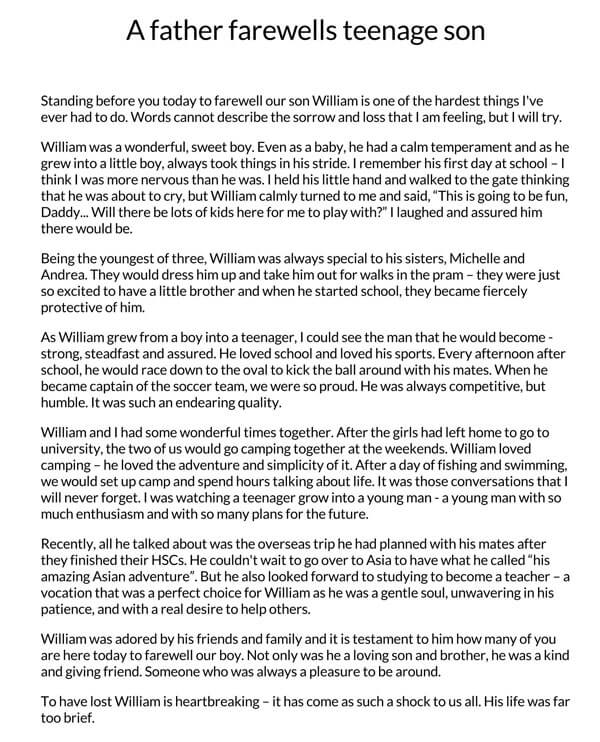
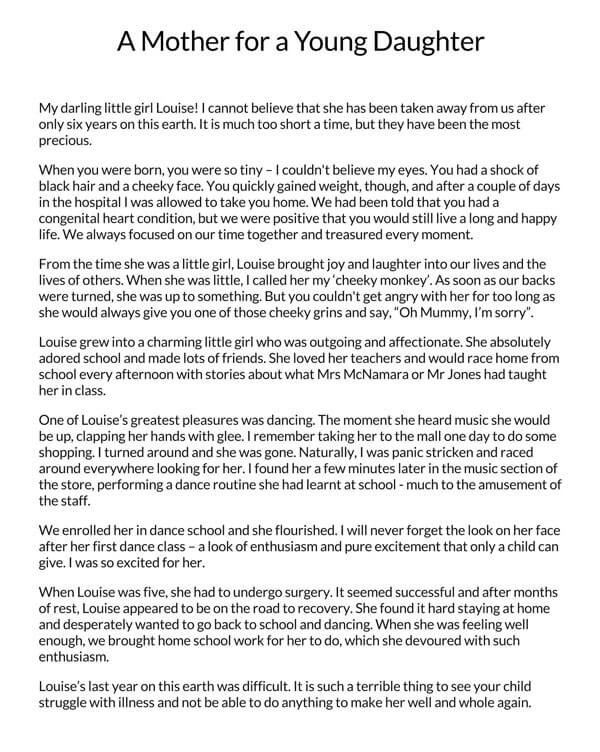



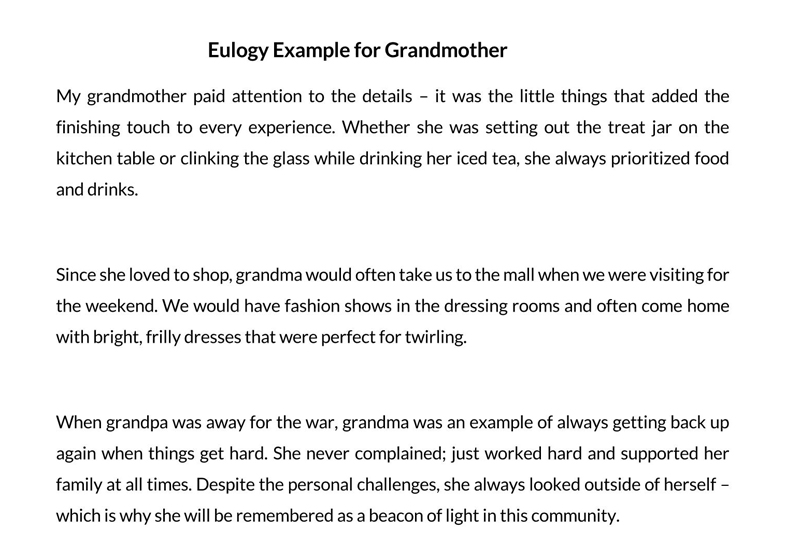
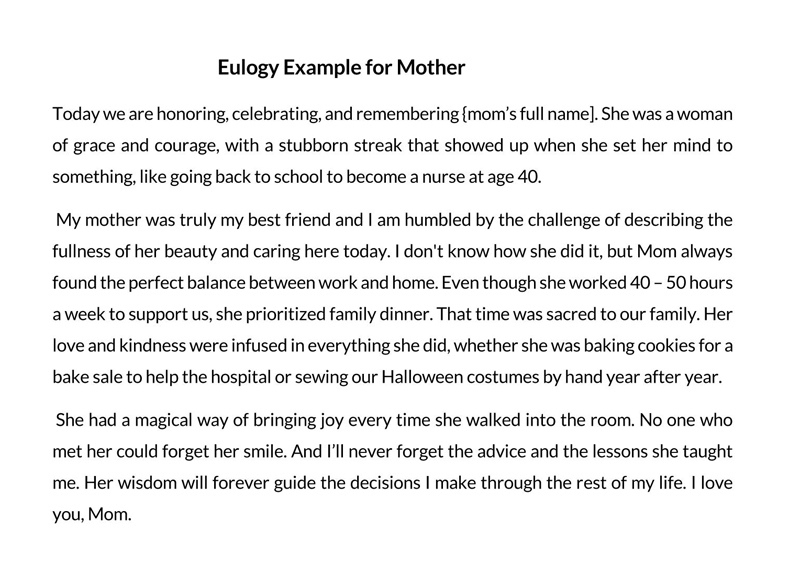

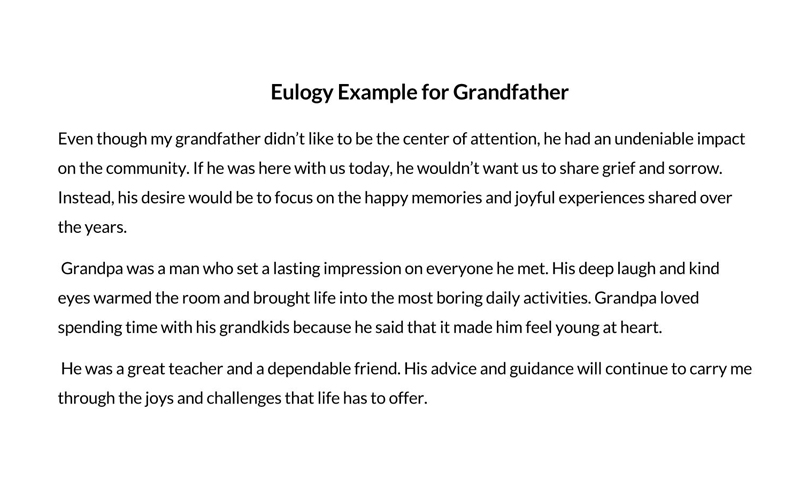

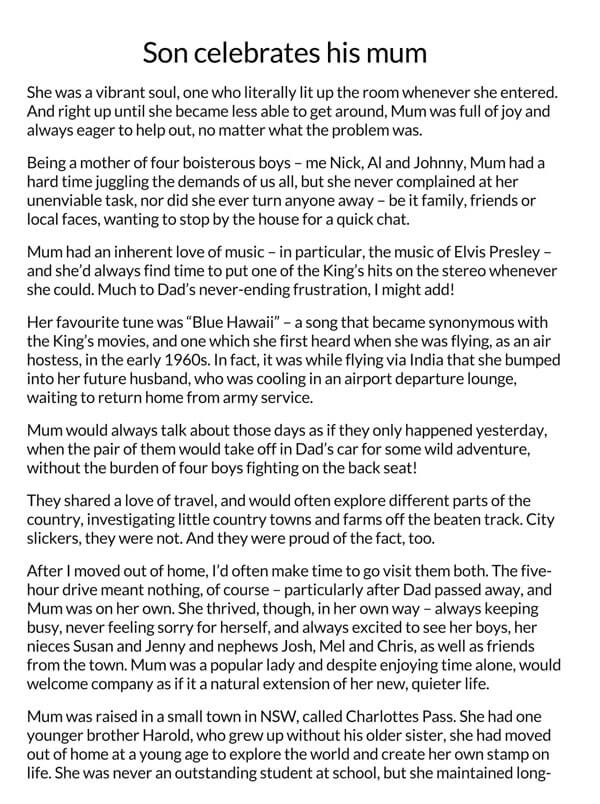
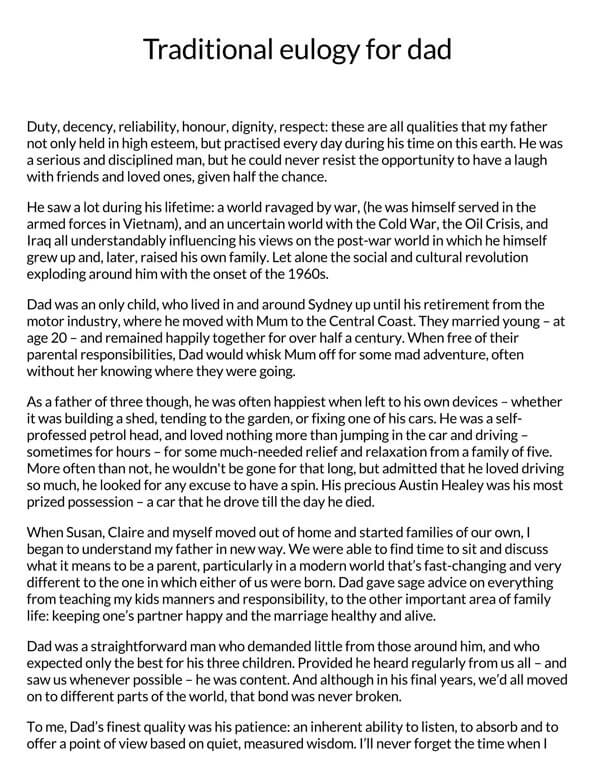
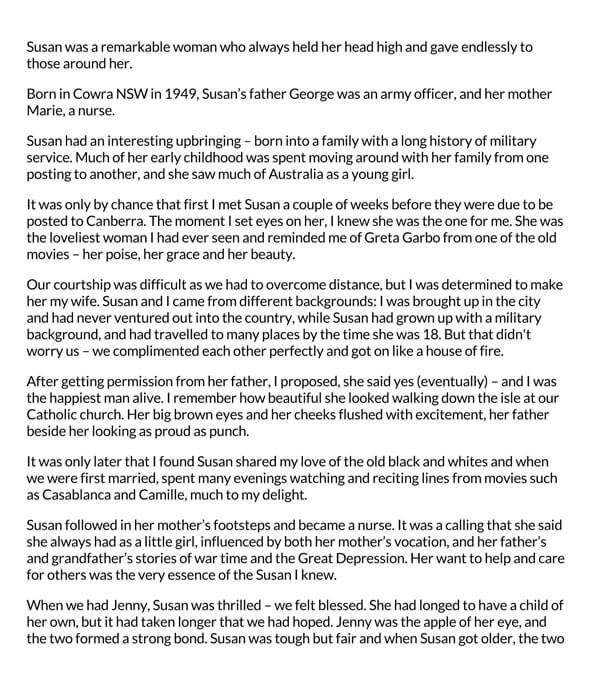
Standard eulogy templates
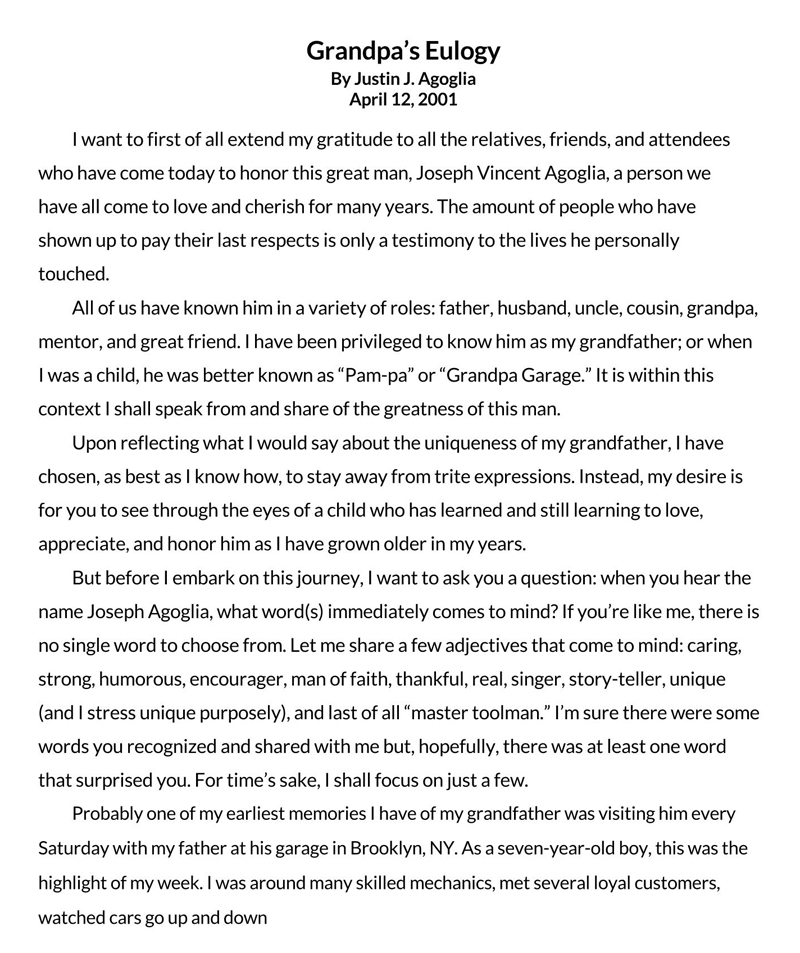
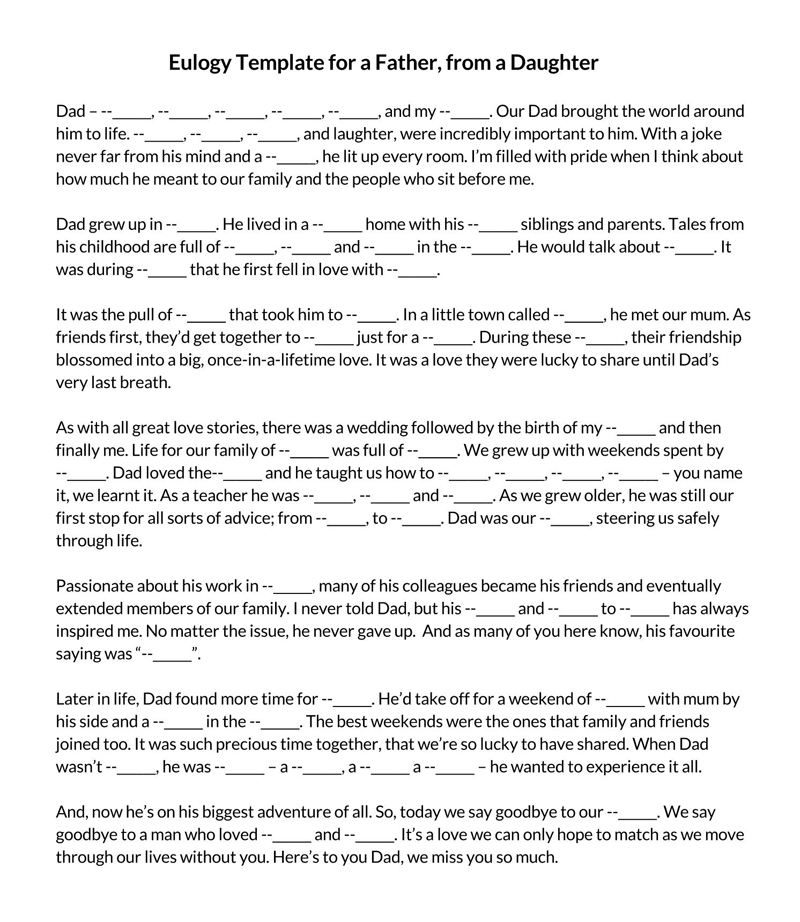

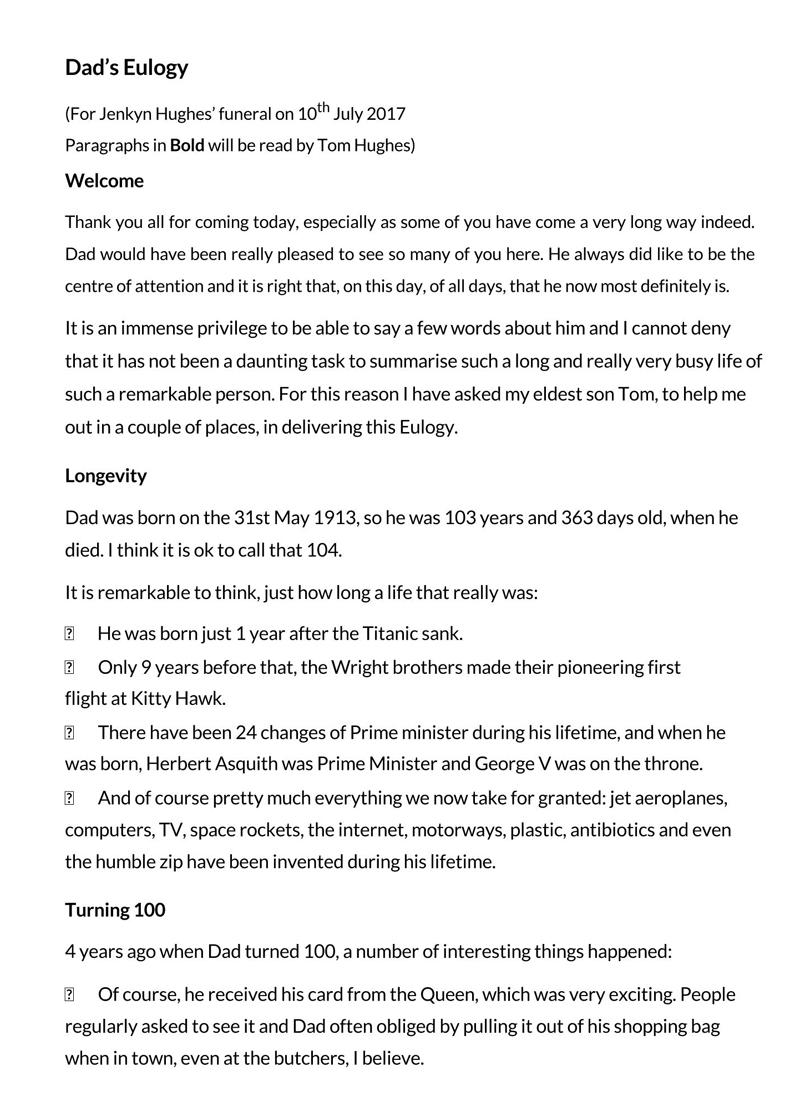

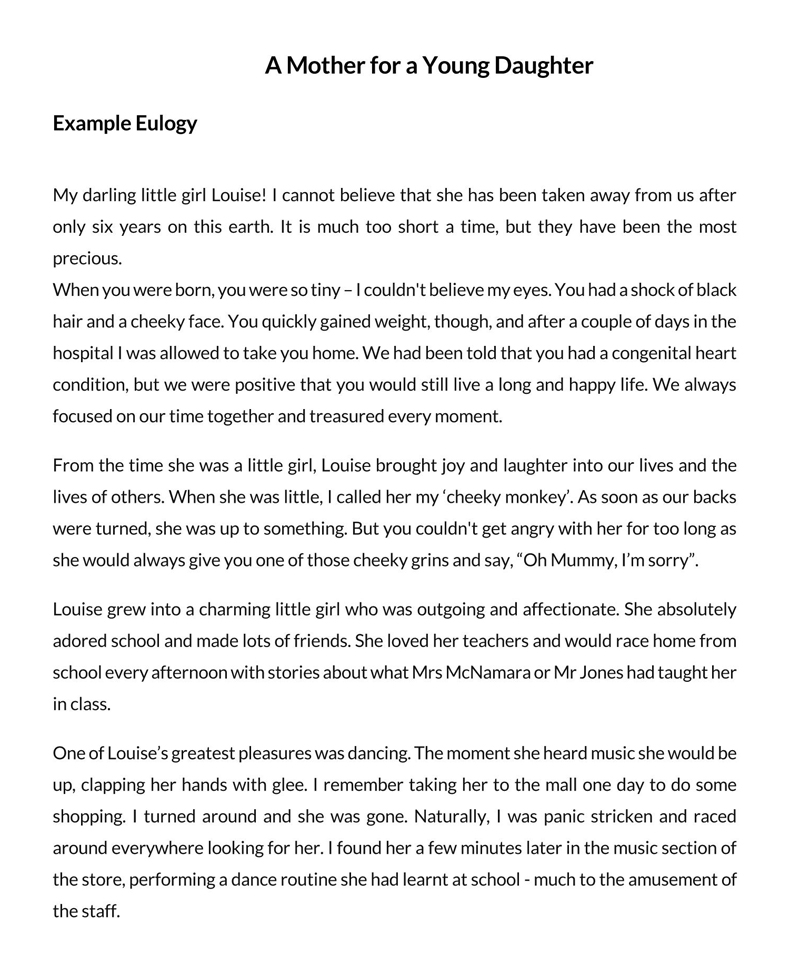

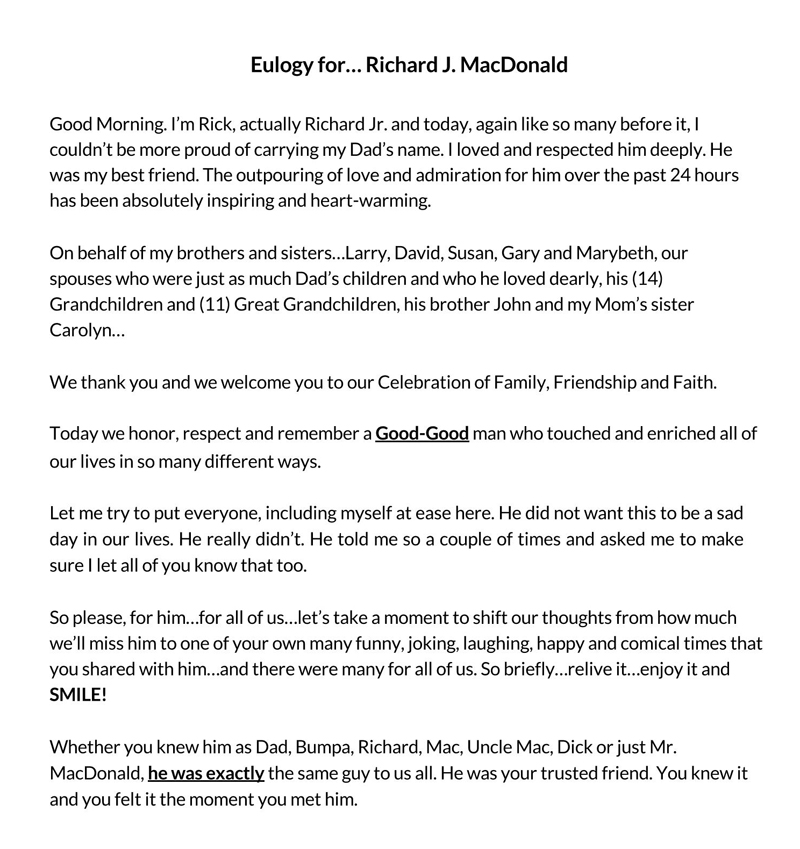
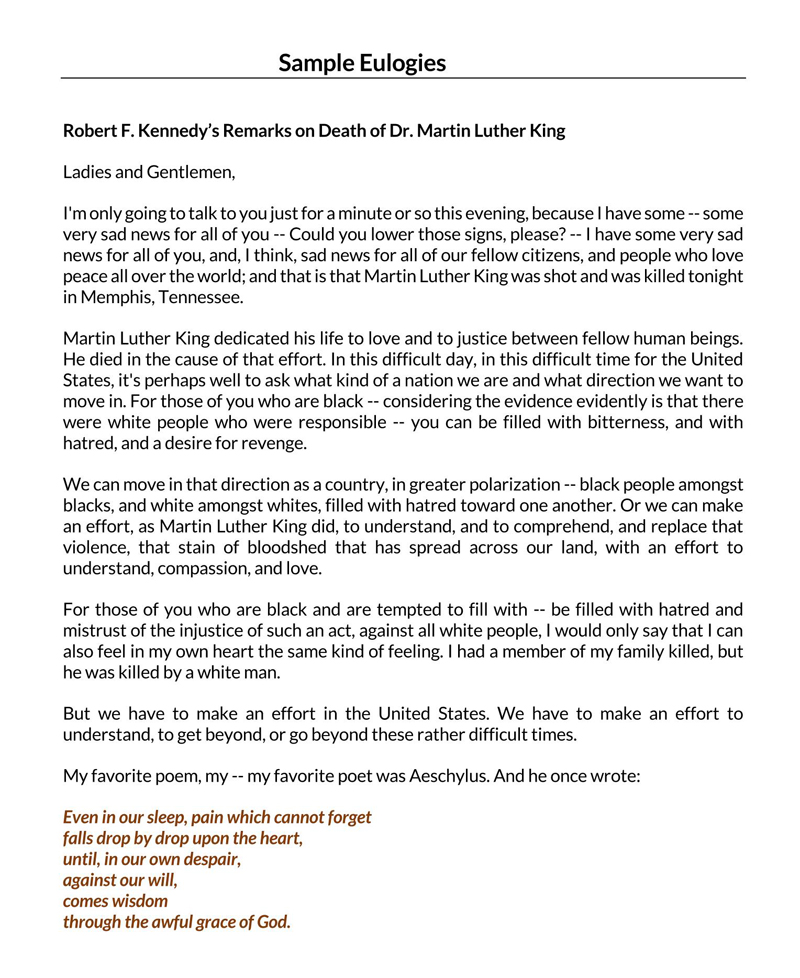
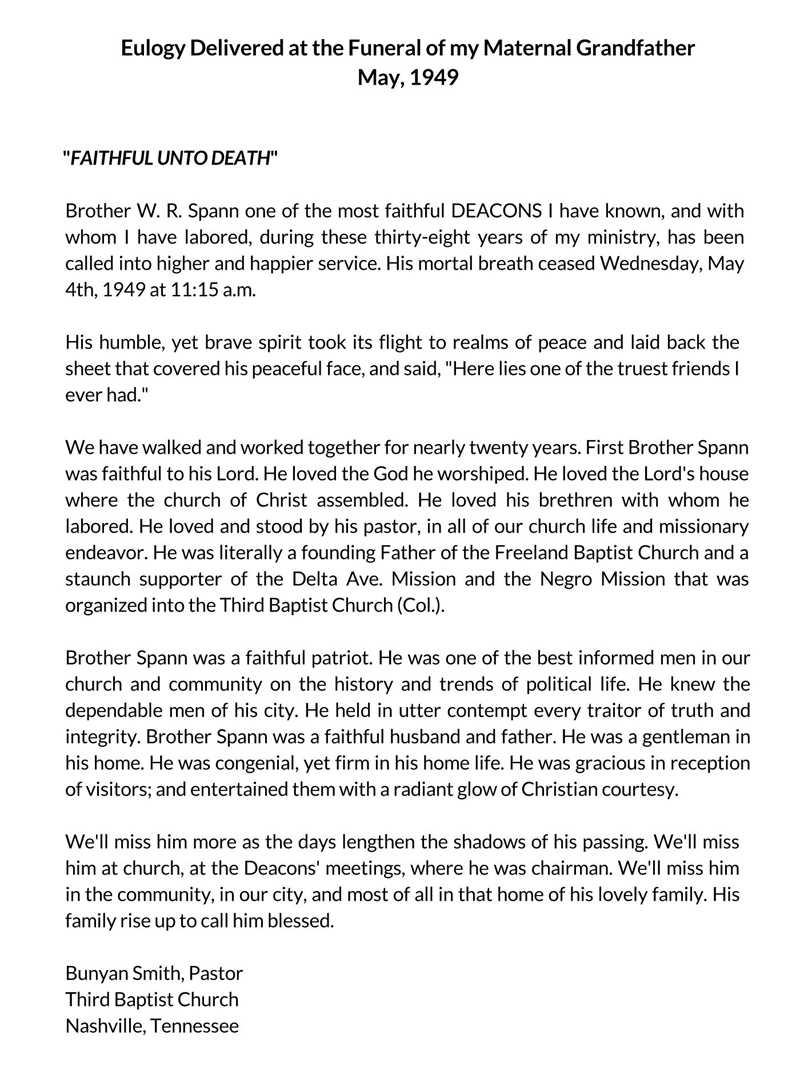
Importance of an Eulogy
When a beloved family member, friend, or colleague dies, all we have left of them are memories through which we eulogize them at a wake or funeral.
note
Anyone from the friend group, family, or workmates of the deceased can write it.
The purpose of a eulogy is to commemorate the life of the person who died and help the mourning family and friends reminisce about their departed brethren as they pay their last respects. As a eulogist entrusted with writing the remembrance speech for the deceased loved one, you should focus on their good qualities, like mentioning their involvement in acts of service and the value they impacted the world. It is essential to have a session during the memorial service and funeral to eulogize the dead, as it helps others grieve and presents a meaningful tribute.
The following points highlight the importance of an eulogy:
Helps other grieve
Grieving a dead family member or friend is considered by psychologists a much-needed step for healing emotional pain and overcoming sadness. Presenting a tribute speech about the deceased helps others grieve by reminding them of their connection with the departed, which significantly provides the mourners with solace.
A meaningful tribute
It importantly helps keep the memory of the deceased loved one alive, which strengthens and comforts the mourning family and friends. Mourners are comforted when they are reminded that the soul of the deceased lives on even after their physical death.
Essential Elements of a Eulogy Template
A template incorporates certain essential elements such as the introduction, birth details of the deceased, names of the family members of the deceased, educational background, and other personal details.
All these elements should cover the information discussed below:
First-section: Introduction
The first section should mainly introduce the deceased to the mourners who came to pay their last respects. The content in the first section of the eulogy should focus on the personal details of the deceased loved one, as indicated below:
When and where they were born
Remember to include when and where the deceased was born to form part of a brief history narrated to the congregation.
The names of their close family
Mention the names of those related to the departed. Start by naming their parents, siblings, aunts, uncles, nieces, nephews, cousins, and grandparents.
Nicknames
Personalizing the template helps mourners reminisce about the deceased better by calling the deceased with nicknames familiar to all people. For example, the birth certificate name for the deceased may be Thompson Andrew, but friends and family popularly knew him as Andy. Hence, using a nickname; such as Andy, sounds more relatable to everyone.
Education
It should recount the educational history and achievements of the dearly departed as part of remembering the deceased’s life.
Contribution(s) to the community
Information about the contributions made by the departed to the community should be detailed. The reason to include community contributions from the deceased is to help mourners remember the value the deceased loved one brought to them.
How they met their spouse or partner
You should narrate how and when the deceased met their spouse if they were married and mention the full names of their spouse. This information aims to paint a picture of the connections and relationships the deceased had to give the mourners a glimpse into the past life of the departed.
Discuss how you know the deceased
In detailing introductory information about the deceased, you should discuss how you know the deceased, including your interactions. You can recount specific details of your interactions where the deceased impacted your life to show the mourners your grieving side and help them remember the dead or discover new aspects of the dead person.
Middle-section: Body section
After the introductory part, the next section is the middle part, considered the longest and most important. The speech in the middle section may follow a specific theme or use talking points to narrate the life or existence of the late.
The eulogist can focus on the following talking points:
- The accomplishments of the deceased
- Childhood years of the late
- The deceased’s impact on the community
- Marriage and children of a dead loved one
- Talk about significant life events of the past, like their wedding, graduation, etc.
- You can also discuss fond memories you have of the deceased
End-section: Wrap up
The shortest part is the end section, which summarizes the life of the deceased. You can wrap up by using some of the options listed below for the end section:
- You can end by encouraging your family and friends to be strong
- Another effective way of closing is to quote a scripture that resonates with the event
- Close by telling friends and family how you wish for them always to remember the late
- State how the deceased would wish to be remembered in the end section of
- End by thanking attendees for coming to pay their last respects to the departed loved ones
How to Write an Eulogy
A eulogy is a sentimental piece of writing that considers significant issues that must be considered before writing an effective one.
Following are the steps for writing an effective one:
Think about your audience
When writing, you must reflect on your audience. The audience will likely be friends and family, but other people could join the service.
When reflecting on your audience, you should consider points such as:
- Who is your audience?
- How would they feel listening to the eulogy of their departed loved one?
- What message do they want to hear through it?
- Lastly, decide the length to avoid stretching the concentration of your audience
There are certain words or stories you may need to leave out when writing the eulogy to avoid hurting the audience’s feelings or annoying them. Note that it is meant to uplift the audience’s spirits as much as it is meant to honor the memory of the dead.
Think about the person by recalling memories
Write from the memories you have of the deceased to help the audience resonate with your words. You can recall the good times, funny moments, and enduring qualities of the dead, which help the audience recreate a picture of the deceased through your words. In addition, you may consult family and friends to obtain photographs and more factual details of the deceased’s qualities to guide you in writing one.
Collect stories and ideas
You can write a eulogy in cooperation with the family and friends of the deceased to gather more information about the late and who he was to different people. An effective one should contain information everyone relates to, which can be achieved by collecting stories and ideas from other people about the deceased and how best to write it.
Choose a theme
When collecting stories and ideas for writing, you could end up with too much content that cannot be included. Therefore, it is advisable to pick a theme to focus your stories on to keep them straightforward and brief. Examples of themes include ‘love of family and friends, selflessness, services to the community, and living one’s faith’.
State the basic information about the deceased
Start with the basic information about the deceased that everyone is likely to know to maintain the concentration of the audience. However, focusing too much on information that only you may know about the deceased may make people drift from the point and lose touch with your content.
Make an outline
To ensure your eulogy covers all essential components and details, you should create a speech outline as depicted below:
Opening:
- Start by thanking the congregation for attending the funeral or memorial of the late
- State your relationship with the deceased
- Highlight critical topics that you will discuss with the deceased.
Early life:
- When and where the late was born
- Point out interesting facts about the childhood of the departed
- Talk about the education, marriage, and children of the dead family member or friend
- Discuss their career
- List the names of the family members
- Concrete events, hobbies, and achievements of the deceased:
- Mention major positive or negative events that impacted the lives of the deceased
- Focus on the hobbies and interests of the late
- Mention what meant a lot to the late
- Highlight main achievements, wards, and recognitions obtained by the deceased
- Memories:
- Note down all significant memories you have of the dead friend or family member you are eulogizing
- Closing:
- End with scripture or song that encourages the mourning friends and family of the deceased
- Thank the attendees for their time
Write the first draft
Begin writing your first draft, which requires too many edits to get the best final copy. Write all your content from the beginning to the end of the first draft to save time when making edits. It may be easier to start writing with stories that make up the body paragraphs of the speech and consider writing the introduction and conclusion last. Beautiful quotes tend to lead to a reasonable conclusion that leaves your congregation with beautiful imaginations about the deceased.
Edit and rehearse
After the first draft is complete, present it to a few family and friends for suggestions on areas that may need editing. After editing, like any other speech, you should rehearse in front of someone to prepare and gain feedback for improvement.
Recommendations to Deliver a Eulogy
Delivering a eulogy is part of public speaking that needs rehearsal and practice to perfect. Here are some noteworthy points to remember:
Memorize as much as you can
To have a good chance of delivering a eulogy, you should memorize the content as much as possible to make it easier to mention the names you may be struggling to pronounce. If you seem to stutter or struggle reading the content of the eulogy, people will think that it was written by someone else or indicate your unpreparedness, which is a negative trait.
Don’t worry if overcome with emotion
When you are delivering the speech, you break down or get overcome by emotions. It would help if you did not panic but gave yourself a little time to recollect and get back to the speech.
Have a standby
When preparing to deliver a speech, make sure you get someone close to you to rehearse to help you deliver the speech in case emotions overcome you on that day.
Wear suitable clothes
You must pay keen attention to your dress by ensuring that your outfit concurs with the theme to avoid distracting your audience. Funerals are commonly known to follow a black outfit theme or clothing with dull or dark colors to show grief.
Speak slowly
To ensure that everyone in the crowd hears what you are saying, speak slowly when delivering a speech. Note that it is a remembrance speech. Hence, it would help if you gave the audience time as you presented to think and recall memories about the deceased.
Use a conversational tone
A soft conversational tone is more appropriate to make the audience feel that they are talking to a friend who shares in their grief.
Pause for thought
You should pause for thought to allow the audience a moment of silence to recount a special memory you have shared about the deceased. Also, it would help if you paused when you made funny comments to allow your audience to smile.
Give people eye contact
Maintain eye contact with your audience. This helps maintain concentration and enhances effectiveness in facilitating the remembrance of the deceased.
Try to stand still
Stand still and don’t fidget when delivering a eulogy speech to show confidence and avoid distracting your audience.
Eulogy Outline Examples
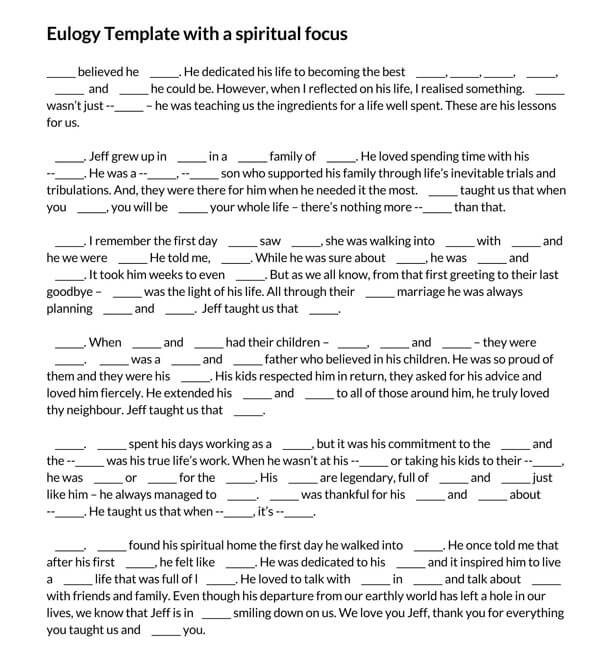



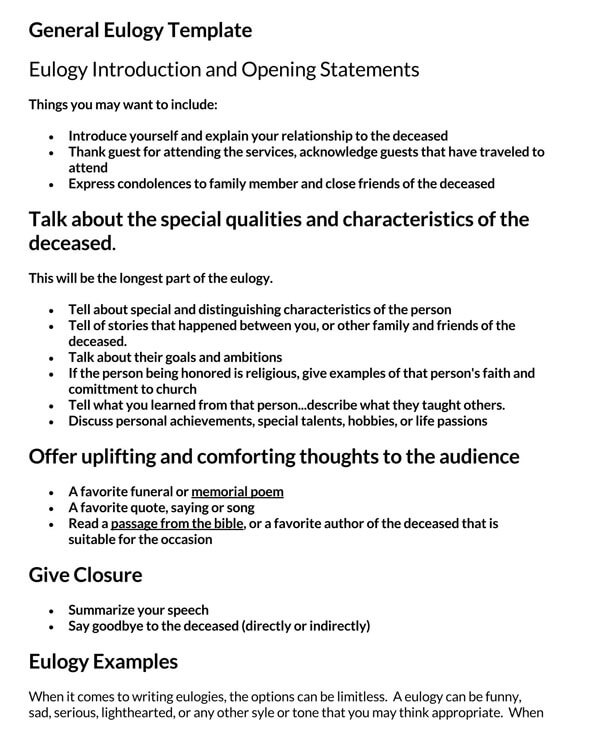
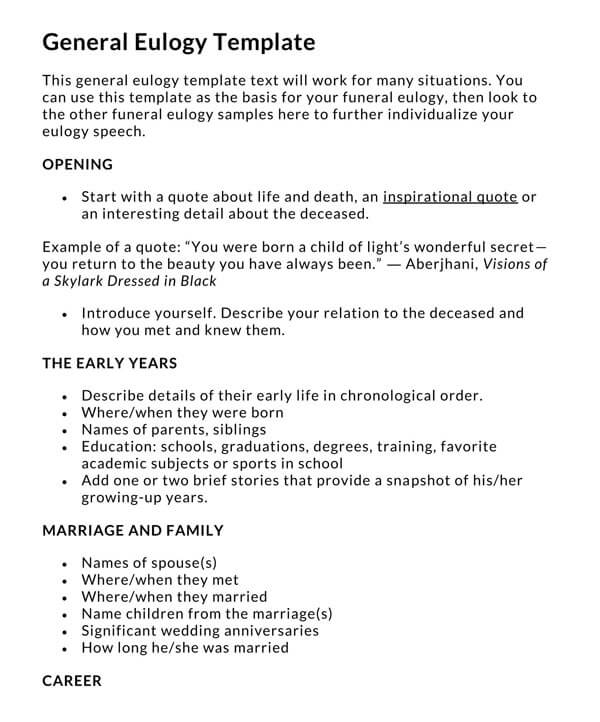
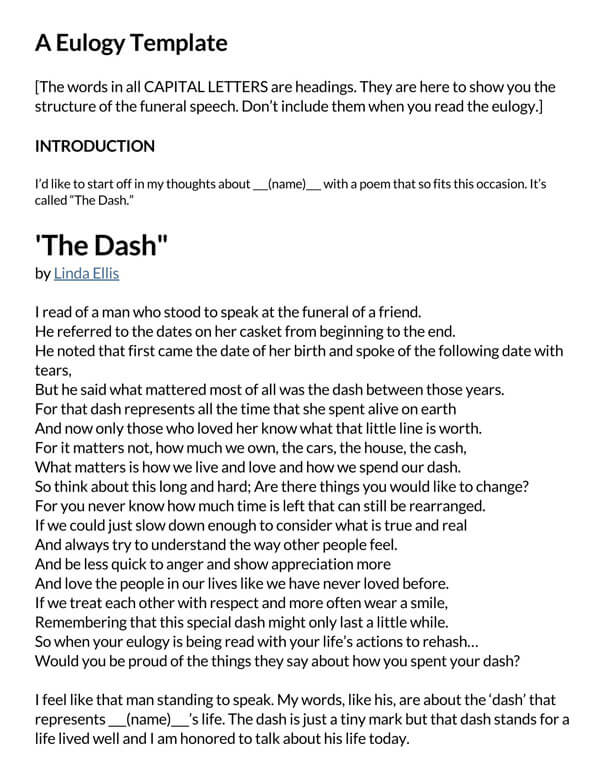
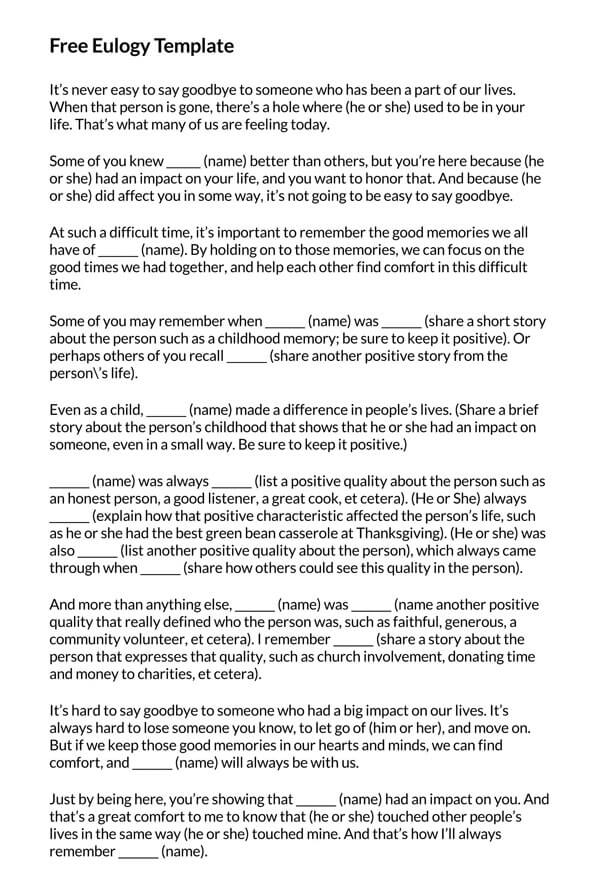

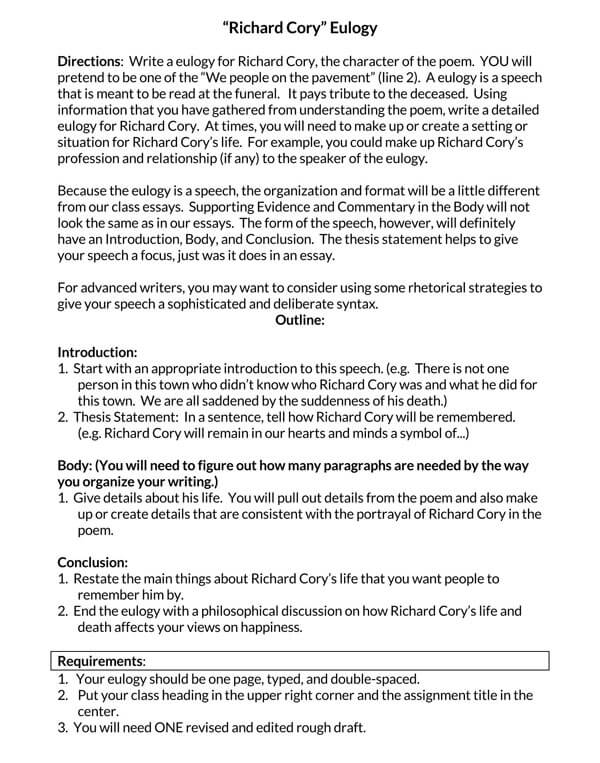
Additional Eulogy-Writing Tips
A eulogy speech is part of the last moments where people officially remember their loved one. This makes it an essential piece of writing that has to appeal to the emotional part of your audience about being late to settle their grief and help them pay their last respects. Therefore, the more you are aware of how to go about preparing a one, the better it is.
The following tips are critical to note when writing an effective eulogy:
Mood board
It should recreate the deceased’s life in the memories of the family and friends through the use of pictures of the life the late had. For example, use pictures of them with family or during special events in their life, like wedding photos.
Timeline
It does not explicitly require you to recreate precise dates when events happened, but creating timelines of the most critical times of the person’s life would help guide you on the contents to add or remove from the speech.
Keywords
Keywords that best describe a deceased’s persona should be used in writing a eulogy. Hence, it would be best to research befitting keywords that suit the nature and qualities of the deceased. For example, Andy was a ‘selfless and kind’ person to everyone.
Decide on the tone
Good communication relies heavily on the proper application of tone; hence, using a conversational tone is considered more appropriate to deliver the friendly feeling needed during that time of mourning.
Write word-for-word
It helps to write the entire eulogy word-for-word. Note that having main discussion points may not be effective since you may be overwhelmed and unable to generate the content you wanted to communicate under the outlines you made. Write word for word and rehearse to memorize the content to make your delivery smooth and effective.
Get feedback
Involve friends and family members to get their feedback and insight that will guide you in writing an appropriate and factual remembrance speech for the deceased. Also, rehearse in front of someone else to get their feedback to help sharpen your delivery skills and content quality.
Think about how you will close
The closing is essential, so plan for it. It could be as easy as just saying goodbye, thanking the congregation, or preparing a shore farewell sentence.
Eulogy Format Examples

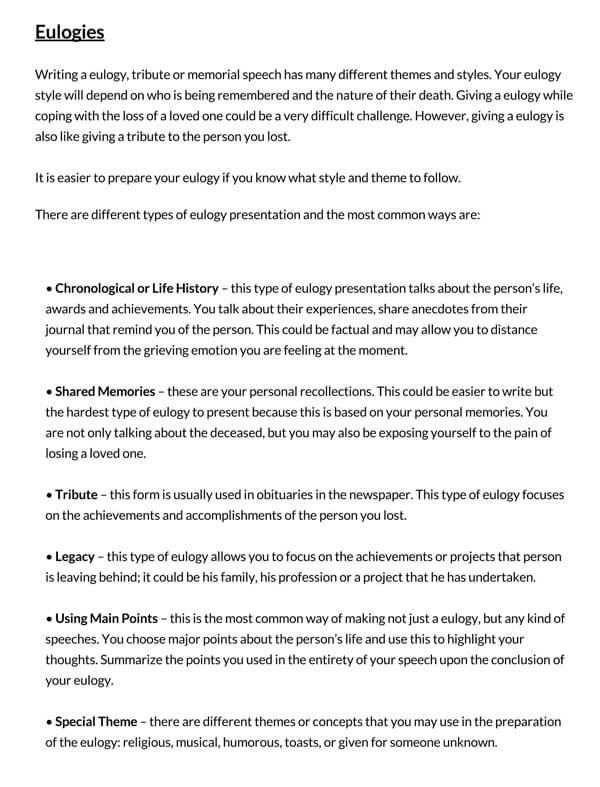
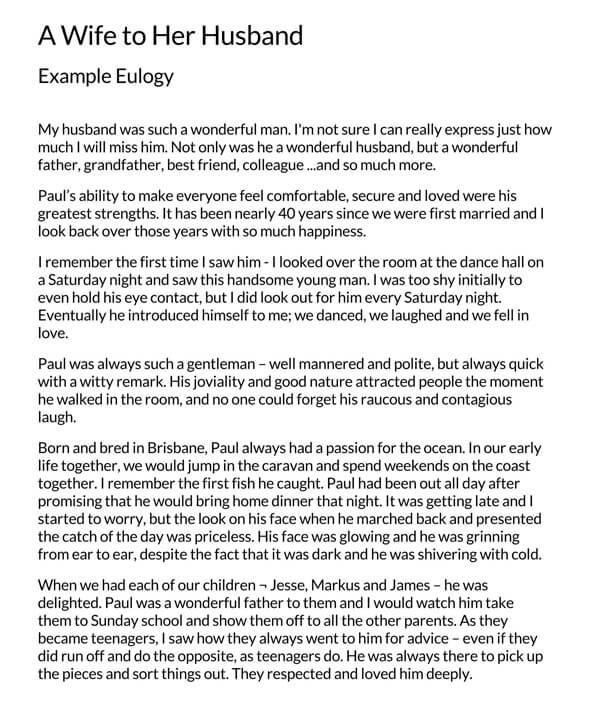



Frequently Asked Questions
The person selected to deliver one at the funeral is always someone with good knowledge of the deceased and who has close relations with the deceased.
A eulogy is a brief speech that takes 3-5 minutes and should not exceed 10 minutes.




